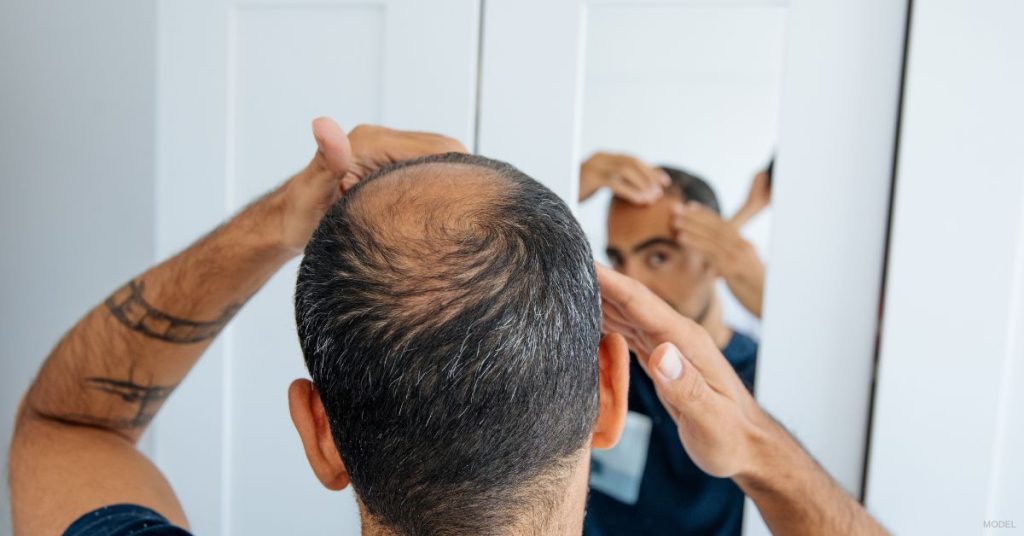PRP stands for platelet-rich plasma therapy, and it involves extracting and injecting growth factors from your own blood to stimulate hair growth in balding areas. It has emerged as an effective hair restoration solution and alternative to hair transplant surgery.
This blog post explains PRP, how it works for hair restoration, and how it stacks up against other hair loss treatments.
Understanding PRP
Platelet-rich plasma has been a valuable treatment in the medical field for decades because it contains growth factors that can trigger cell reproduction and stimulate tissue regeneration or healing in the treated area. The process of creating platelet-rich plasma begins with drawing your blood and placing it into a centrifuge, a machine that spins at high speeds to separate the blood into components, including PRP. You provider then injects that PRP into the balding area of the scalp after using a topical numbing agent to minimize discomfort.
How Does PRP Result in Hair Growth?
PRP injections for hair loss work when the growth factors stimulate hair follicle cells that play a vital role in hair growth. This encourages the hair to enter the growth phase of the hair cycle. Over time, this can lead to thicker, stronger hair and even the regrowth of hair in areas where it has thinned.
Who Is a Good Candidate for PRP Hair Restoration?
PRP therapy is particularly effective for individuals experiencing androgenetic alopecia, commonly known as male or female pattern baldness. It is most beneficial if you’re in the early stages of hair loss when hair follicles are still present but may be dormant. You may not be a good candidate if you take blood thinners, have a thyroid condition or blood disorder, or are a heavy smoker.
How Does PRP Compare to Other Hair Loss Treatments?
The beauty of PRP is that it uses your blood, making it a natural and safe option for many people. However, PRP isn’t a one-and-done treatment. Most patients require multiple sessions, typically spaced 4to 6 weeks apart, followed by maintenance treatments every few months to sustain the results.
We offer alternatives to PRP for hair loss patients. These include:
Topical and Oral Medications
Topical treatments like minoxidil (Rogaine®) and oral medications like finasteride (Propecia®) are often the first line of defense against hair loss. These treatments work by stimulating hair follicles and preventing additional hair loss. However, they require consistent, long-term use to maintain results, and stopping treatment can lead to the loss of any gains made. We may recommend combining PRP with these treatments to enhance results, but unlike these medications, PRP uses your body’s own growth factors.
KeraLase
Combining the Lutronic LaseMD Ultra® laser with high concentrations of 5 growth factors and proteins called KeraFactor® serum helps stimulate and maintain hair growth. The laser creates microchannels in the scalp, making it easier to absorb the serum. The treatment only takes about 10 minutes and is typically painless. To achieve the best results, we recommend that the treatment be performed every 2 weeks for 6 treatment sessions.
Alma TED
This option uses ultrasound technology to deliver medicated serums rich in growth factors directly to the scalp’s deeper layers. The heat generated by the ultrasound energy causes bubbles to develop in the scalp’s fatty barrier, enabling the serum to penetrate below the scalp to the hair follicles.
Both Alma TED and KeraLase treatments enhance the scalp environment for hair growth, similar to PRP, but they use different technologies and delivery methods. PRP might be preferred by those seeking a more natural approach using their own biological material.
Vitamin Supplements
Vitamin supplements, or nutraceuticals, for hair loss often include biotin, zinc, and other nutrients believed to support hair health. While they can be beneficial for individuals with specific nutrient deficiencies, their effectiveness in treating genetic hair loss is limited compared to PRP, which directly targets hair follicles with growth factors. We often recommend nutraceutical supplements to support hair restoration treatments like Alma TED, PRP, or KeraLase between treatments.
Which Is Right for You?
PRP has shown promise in increasing hair density and thickness, but results can vary based on individual factors like the extent of hair loss and the underlying cause. We’ll discuss all your options, including combining different hair loss treatments. It’s important to have realistic expectations and understand that hair restoration treatments aren’t a cure for hair loss, but they can improve hair density and slow down the progression of hair loss. You can read more about your advanced hair restoration options in a previous blog post.
Explore Your Hair Restoration Options
PRP therapy offers a unique approach to hair restoration by using the body’s own growth factors to stimulate hair growth. You can request a consultation to discuss your concerns and goals and determine the best approach for your specific needs. Use the online form or call us at (202) 393-7546 to schedule an appointment.







Leave a Reply